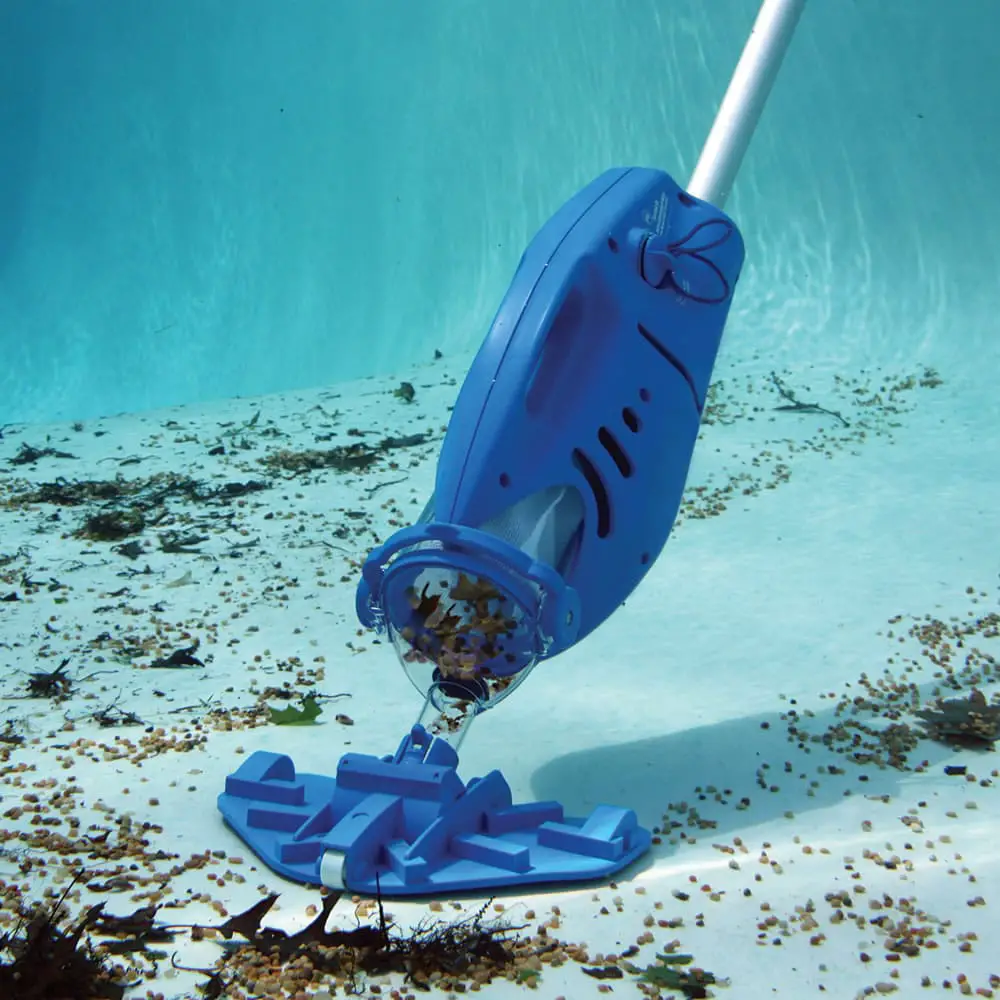
Want to learn more about algaecide? Read on to find out when to add algaecide to your pool maintenance routine and other helpful tips.
Every swimming pool, whether it’s saltwater based, chlorine, or full of jello- will need to be vacuumed regularly in order to stay healthy and well-maintained. No one likes to spend their days cleaning, especially in the heat of the summer. Luckily for you, there are a couple of pool vacuums to choose from. In this article, we will cover four kinds of swimming pool vacuums: manual, suction, pressure, and robotic.

The manual vacuum is by far the cheapest pool vacuum cleaner, but also most labor intensive. To vacuum your swimming pool manually, you connect the hose to the skimmer. This sucks the water from the pump into the cleaner, much like how a suction-side cleaner operates. After attaching the hose to the skimmer and pump, you connect a long pole to the manual cleaner and begin to push it around your swimming pool. Manual pool cleaners involve lots of patience and energy, but it’s easy to learn and master. It will feel a lot like vacuuming the carpet in your home. If you are looking to buy a pool vacuum without too large of a learning curve, it is a great option for first-time pool owners.
A suction pool vacuum is hooked up to your swimming pool pump. The suction from the pool pump allows the vacuum to suck up the debris and dirt. It uses a long hose attached to the skimmer where the water pump intake system sits. This allows it to become a fully immersed, water-based vacuum cleaner. While some suction vacuums have their own filter bag, most use your pool’s filter to clean up. To maintain your suction pool vacuum, you will need a well-functioning pool pump. You will also need to backwash the filter and empty the skimmer basket after each pool cleaning. Because the pool pump provides the power for the vacuum, you will notice an increase in your electricity bill. Despite the increased expense on your electricity bill, the suction pool vacuum is one of the cheapest options available.
Like a suction pump, pressure pool vacuums rely on your swimming pool pump. Instead of connecting to the pump’s skimmer, it attaches itself to the pressurized side of the pump, where the water is taken from the pool into the pump. This is how it earned its name “pressure-side vacuum”. When the pressurized pool water is pumped through the cleaner, it begins to power the vacuum’s wheels and sucks up dirt, debris, and bacteria in your pool. Similar to robotic cleaners, pressure-side vacuums include their own filters, which extends the life of your swimming pool filters and will not need to be backwashed after each use. Because the pressure vacuum is attached to the pool pump, expect and increase in your electricity bill as you would with the suction vacuum.
Pool vacuum robots are user-friendly and easy to program. While they are one of the more expensive options, robotic pool vacuums do not require a separate bag or filtration system. They don’t need to be attached to a pool pump or water circulation system. Once they are plugged in and programmed, you just drop ‘em in the water and let them get to work! When the robot vacuum is in use, it is best to turn off your pool pump. This is so that the dirt, debris, and bacteria will settle to the bottom of the pool and allow the vacuum to reach it. The other benefit of using an automatic pool vacuum and turning your pool pump off when cleaning is that it lessens the wear and tear on the pool pump, which overall extends its life and usage. While a robotic pool vacuum may be on the more expensive side, it is an investment that comes with other cost-friendly benefits.
Try out our Pool Calculator as you clean and maintain your pool! For more information on how to care for your swimming pool, see our blogs on Pool Maintenance

Want to learn more about algaecide? Read on to find out when to add algaecide to your pool maintenance routine and other helpful tips.

In this quick guide, we’ll answer the question “can you over shock a pool” and unveil the factors to consider when shocking a pool.

Maintaining both pH and total alkalinity in your swimming pool is important for keeping your pool properly sanitized and non-corrosive. Total alkalinity is to pH what cyanuric acid is to free chlorine. Total alkalinity stabilizes pH levels. The ideal pool pH level is 7.4 to 7.6. The ideal total alkalinity level is 80 to 120 ppm.

The Association of Pool and Spa Professionals recommends free chlorine levels for both swimming pools and hot tubs be kept between 2.0 and 4.0 ppm. However, the Center for Disease Control recommends free chlorine stay above 1 ppm in pools and 3 ppm in hot tubs.